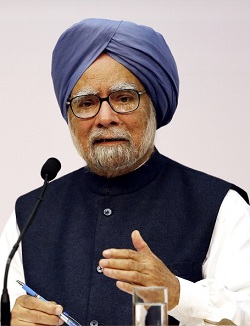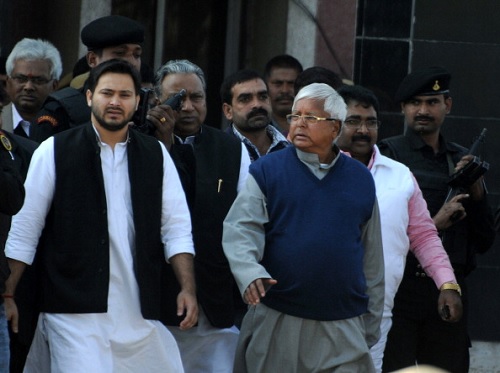Jan 07, 2026
Jan 07, 2026
by Sakshi
PM’s Swan Song
Annus Horribulus
Youth and Restlessness
Lalu, the Incorrigible
Where are We Heading?
Fresh Isn’t Better
Think it Through
PM’s Swan Song
The great news of the new year is the press conference of our speech-shy Prime Minister – his third and probable the last before he relinquishes office after ten years of eminently forgettable (mis)rule which will unfailingly be remembered, in WH Auden’s memorable phrase as “a low dishonest decade.”
 The main purpose of the 1463-word prepared text, interspersed with nearly a score of pompous – I did this, I did that – was to tell us publicly that the Congress vice president Rahul Gandhi has “outstanding credentials” to be nominated as the UPA’s prime ministerial candidate. Who didn’t know about it? What Manmohan Singh forgot to mention was that in true Mughal tradition he was stepping down as Regent to the heir apparent of the New Mughal dynasty, founded by Jawaharlal Nehru. His was the memorable role comparable only to Bairam Khan who was appointed Regent over the young monarch Akbar following Humayun’s death in 1556.
The main purpose of the 1463-word prepared text, interspersed with nearly a score of pompous – I did this, I did that – was to tell us publicly that the Congress vice president Rahul Gandhi has “outstanding credentials” to be nominated as the UPA’s prime ministerial candidate. Who didn’t know about it? What Manmohan Singh forgot to mention was that in true Mughal tradition he was stepping down as Regent to the heir apparent of the New Mughal dynasty, founded by Jawaharlal Nehru. His was the memorable role comparable only to Bairam Khan who was appointed Regent over the young monarch Akbar following Humayun’s death in 1556.
He also had lashed out at NaMo. It will, he warned us, “be disastrous for the country to have Narendra Modi as Prime Minister.” Indeed! He “presided over massacre of citizens on the streets of Ahmedabad”. That was in 2002. Don’t ever ask what triggered those riots? Godhra is a tabooed word in secular India. Reason? Those Hindus kar–sevaks who were roasted alive were children of a lesser god like the 4000 odd Sikhs who were butchered by Congress goons in the streets of Delhi in 1984 and Rajiv Gandhi presided over the gory affair. But, how unforgivable of me to forget that one was a prince of the ruling dynasty and the other happened to be ex-chai-wala.
Now that Manmohan Singh has taken the initiative let’s wait for Modi’s lunge at his next rally.
Whenever a New Year begins, I think it would indeed be annus mirabilis i.e., “wonderful year”, infinitely better than annus horribilis i.e., the horrible year that has just ended. And wasn’t 2013 horribly grey and grim? It witnessed the fall and fall of all things worthwhile, particularly moral standards of those whom we have entrusted to look after the nation’s affairs. I was deeply disillusioned how things went all through the year. Above all, our Parliament and state legislatures hardly functioned. Their members were duly paid, nonetheless. Yes, somehow the Lokpal Bill became an Act. But don’t forget it has been in the making for 46 long years.
All the New Year greeting cards that landed at my desk wished a Happy New Year. Happiness, I find, is a frightfully evasive term. Look at the Americans. Ever since the 1776 Declaration of Independence (drafted by Thomas Jefferson), they have been in hot chase of that precious commodity called Happiness. Jefferson’s original draft reads:
We hold these truths to be sacred & undeniable; that all men are created equal & independent, that from that equal creation they derive rights inherent & inalienable, among which are the preservation of life, & liberty, & the pursuit of happiness; ...
Of course by all men, he meant exclusively white WASPs – Western Anglo-Saxon Protestants, including that rare exception – his black mistress.
Where has the Americans’ pursuit of happiness led them to? Do you also want to land in that world?
Who, according to you, should feel more tired: young or old? What a naive question, you’ll say. Of course the old feel more tired. Age does it.
Your answer, I’m afraid, is incorrect. A recent study conducted by the prestigious London School of Economics and Finance that focused on nearly 13,000 Americans, reveals something entirely different. Participants were quizzed on their lifestyle habits including employment, family life, hours slept each day and questions about general health. To the utter surprise of researchers, the youngest group in the study – those between 15 and 24 – reported the most fatigue.
And the difference between young people and seniors was close to a full point higher in favor of the elders based on a scale of 0 to 6, with 6 representing “very tired.” One of the authors of the study pointed out that since older people are less inclined to use social media, “They may not have their attention drained the way that younger people might.”
Now what do you say?
Flattery and sycophancy are well-cultivated arts – or are they crafts? – since time immemorial, especially in societies where durbari culture prevailed, and it did in ours. Of course, with the spread of democracy and disappearance of absolutist monarchies and dictatorships (except in the Gulf and North Korea and Albania), in most of the world there is no compelling need to concur with everything that the people at the helm of affairs said or did. You’re free to think for yourself and a right to express your views. Our Constitution guarantees Indian citizen certain fundamental rights, which include the right to express your views.
Ji Hazoor is the name of a professional flatter. And the art of flattery is called ji-hazoori. And ji-hazoori is endemic in our culture. In our society, it is a long-lasting hangover of our long-lasting feudal past. If the ruler of the day calls it is day, you’re supposed to endorse it full-throatily and call it bright day light even if it is pitch dark. And if the person that matters sings any tune you have to describe it as the most beautiful melody that ever was sung.
Our polity has all sorts of ji-hazoors at the beck and call of the royal court at 10, Janpath and 24, Akbar Road. Not just that. At all levels there are mini courts presided by provincial satraps. Ji-hazoori is practiced by all time servers at various levels.

Indian politician Lalu Prasad Yadav (R) walks with his son Tejaswi (L)
and security personnel as he leaves Birsa Munda Central Jail in Ranchi
on December 16, 2013, following his release from the prison.
Yadav, the head of the Rashtriya Janata Dal (RJD) party
has been released some two-and-a-half months
after he was convicted in a fodder scam case.
Lalu Yadav, today, is a politician in political wilderness. Somehow he has managed to obtain a bail. Understandably, his supreme concern now is how to rehabilitate himself politically. His traditional MY (the much-exploited Muslim & Yadav vote bank) formula doesn’t work in changed circumstances. Isn’t any more a milch cow! He is seasoned enough to know that. How to dislodge Nitish Kamar? – his bête noir – is his supreme concern. Your enemy’s enemy is my friend is the good old political formula as old as the hills. And Lalu is playing that.
His political formation called Rashtriya Janata Dal (RJD) maintains that Bharatiya Janata Party (BJP) prime ministerial candidate Narendra Modi and Aam Aadmi Party (AAP) chief Arvind Kejriwal are no match to Congress vice-president Rahul Gandhi. Who ever thought they are? Rahul is Rahul – a priceless political gem. That upstart Kejriwal is no patch on Lalu’s new hero.
“In a month, people of Delhi will realize that they have made a mistake, in choosing AAP,” warns Lalu. Now after a month or two, when Kejriwal cannot deliver, don’t say “we weren’t forewarned?
It was Schumpeter who first of all drew attention to planned obsolescence or built-in obsolescence in industrial designing with a view to ensuring a limited useful life of a product so it will become obsolete, that is, unfashionable or no longer functional after a certain period of time. Planned obsolescence spurs industrial growth by ensuring continuing pressure on a consumer to purchase again, whether from the same manufacturer or from a competitor who might have a better version to offer.
For industry, planned obsolescence stimulates demand. Isn’t it in the long run ruinous in so far as nonrenewable resources are being wasted just to stimulate demand? That was Gandhi’s criticism of industrial civilization. And irrefutably valid too! Philosopher Herbert Marcuse too has severely criticized the economic and societal implications of this model.
I brought this up after reading about what the Apple CEO Tim Cook said in a letter to its employees. The industry’s great innovator – the creator of iPhone, smartphone and iPad tablet – has “big plans” lined up for the next year. Very good for Apple, its stock-holders and its future! But should all users of Apple appliances discard every year what they bought, say, a year back and go in for the so-called latest version which would, in any case, be outdated in another few months. Is it benefitting us all in terms of deployment of resources we are blessed with?
I still think the purpose of a phone – does it matter if it is landline or the latest smartphone? – is to communicate. And what does it matter if I read the latest Email right now or after half an hour and send my reply immediately by my BalckBerrry?
My wife firmly believes that fresh, seasonal vegetables and fruits are better than their frozen counterparts. You know how difficult it is to talk women out of their well-entrenched beliefs.
I showed her the findings of a new study that counter the traditional view that by the time most fruit and vegetables travel from farm to store to fridge, and then to the table, they’ve already lost most of their nutritional advantage. Researchers recently compared the vitamin and mineral contents of fresh and frozen blueberries, strawberries, broccoli, green beans, corn, spinach, cauliflower and peas in three southern U.S. states. In most instances, the frozen produce was shown to contain the same level of nutrients as the freshly-picked samples – and in some cases even more. In each state, the frozen peas had more vitamins C, A and folate than the fresh ones.
The French novelist Andre Gide famously cautioned: “Believe those who are seeking the truth. Doubt those who find it.”
Ramakrishna said those who really have found it go silent. They are called Thathagata. We had only one.
Images (c) gettyimages.com
05-Jan-2014
More by : Sakshi